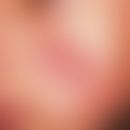Synonym(s)
DefinitionThis section has been translated automatically.
Variant of lichen planus linked to the hair follicles. The disease can occur ubiquitously, but manifests itself preferentially in the neck region and on the capillitium(lichen planus follicularis capillitii). In case of conically pointed follicular hyperkeratosis, it is also called lichen planus acuminatus (lichen ruber acuminatus) (see Fig.).
The occurrence of lichen planus follicularis on the trunk with lichen planus of the main hair (with pseuopelade condition) as well as dystrophic nail changes is also called Graham-Little syndrome.
ManifestationThis section has been translated automatically.
You might also be interested in
LocalizationThis section has been translated automatically.
ClinicThis section has been translated automatically.
HistologyThis section has been translated automatically.
Differential diagnosisThis section has been translated automatically.
Lichen planopilaris (LPP) as a partial symptom of keratosis pilaris
Tuberculosis cutis lichenoides: Very rare clinical picture; symmetrically arranged, disseminated or also grouped, always follicular or perifollicular, pointed conical, yellow-brown, reddish or skin-colored, lichenoid papules, sometimes solitary, sometimes confluent.
Pityriasis rubra pilaris (pityriasis rubra pilaris type 1/classical form): extensive, pityriasiform, often marginal, sharply defined, follicular erythema, also lichenified papules or plaques on the capillitium, face (especially eyebrows, nasolabial folds), also on the trunk.
External therapyThis section has been translated automatically.
Internal therapyThis section has been translated automatically.
Progression/forecastThis section has been translated automatically.
Note(s)This section has been translated automatically.
LiteratureThis section has been translated automatically.
- Chieregato C et al (2003) Lichen planopilaris: report of 30 cases and review of the literature. Int J Dermatol 42: 342-345
- Gupta SN, Palceski D (2003) Lichen planopilaris presenting as truncal alopecia: a case presentation and review of the literature. Cutis 72: 63-66
- Mirmirani P et al (2003) Short course of oral cyclosporine in lichen planopilaris. J Am Acad Dermatol 49: 667-671
- Vaisse V et al (2003) Postmenopausal frontal fibrosing alopecia: 20 cases. Ann Dermatol Venereol 130: 607-610
Incoming links (15)
Acuminate lichen; Frontal fibrosing alopecia; Graham-little, gordon; Graham-little syndrome; Keratosis pilaris; Lichen acuminatus; Lichenoid tuberculid; Lichen planopilaris; Lichen plan péripilaire; Lichen planus atrophicans; ... Show allOutgoing links (9)
Glucocorticosteroids; Graham-little syndrome; Keratosis pilaris; Lichenoid tuberculid; Lichen planopilaris; Lichen planus classic type; Lichen planus follicularis capillitii; Pityriasis rubra pilaris (adult type); Ulerythema ophryogenes;Disclaimer
Please ask your physician for a reliable diagnosis. This website is only meant as a reference.










